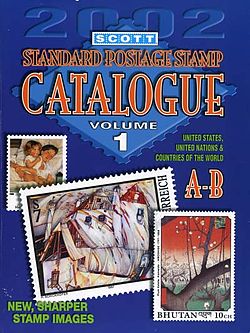Background

The first Scott catalogue was a 21-page pamphlet with the title Descriptive Catalogue of American and Foreign Postage Stamps, Issued from 1840 to Date, Splendidly Illustrated with Colored Engravings and Containing the Current Value of each Variety. It was published in September 1868 by John Walter Scott, an early stamp dealer in New York, and purported to list all the stamps of the world, with prices for each. A notice inside does caution the reader that "it is simply impossible for any one to always have every stamp" in stock. The original catalog has been reprinted.

In subsequent years, the Scott company gave up dealing in stamps but continued to publish the catalog, gradually providing more detail as the hobby evolved and collectors became more sophisticated. In addition to the factual information about the stamps, the catalog includes price information based on market analysis and reported sales from the previous year. As of 2006, and despite annual changes to save space, the catalog was more than 5,000 pages.
The Scott numbering system assigns plain numbers for regular mail stamps, and uses capital letter prefixes for special-purpose types, such as "B" for semi-postals and "C" for airmail. The numbers are generally consecutive; there are gaps among older stamps, where some numbered types were later renumbered, and among newer stamps where Scott has left numbers unassigned in the anticipation of additional stamps in a series. If more stamps than expected appear, Scott will add a capital letter as suffix, or if the change is very recent, it will renumber stamps. Minor variations, such as shades or errors, get a lowercase letter; so the "C3a" above indicates a variation (error in this case) on what is listed as the third U.S. airmail stamp.
Because of its commercial importance the publishers of the Scott Catalogue claim copyright on their numbering systems, and grant only limited licenses for their use by others. The inconsistency with which Scott enforced these licenses resulted in a lawsuit by Scott against Krause Publications (publishers of the Minkus Catalogue) for copyright infringement. After Krause filed a defense, the suit was settled out of court, and Krause continued to reference the Scott numbers. [2]
Editors of this, the dominant catalog in the United States, have great influence over what is and is not considered to be a valid postage stamp. For instance, in the 1960s the countries of the United Arab Emirates issued many stamps that were likely never actually on sale in a post office, so Scott does not list most of them. One must go to a Michel catalog, for instance, to see them described. The lack of a Scott listing, though, means that most American dealers will refuse to trade in such stamps.
Similarly, Scott lists most stamps from countries embargoed by the U.S. government, and in some cases lists them without catalog values. To some extent, this is unavoidable, since the ban on importation means that Scott's editors are unable even to acquire copies of the stamps to be described. Moreover, since American dealers and collectors are unable to buy the stamps legally, they are unlikely to have any need of the data. (Again, interested persons typically use Michel or other catalogs instead.) The policy changes with government policy; stamps of Cuba, Libya and North Vietnam now appear in the Scott catalogues after an absence of some years.[ when? ]
The dominance of Scott is such that U.S. collectors know many of the numbers by heart, and dealers need only mention the number in their price lists. For instance, United States no. "C3a" is instantly recognized as the Inverted Jenny, a rare airmail inverted error stamp.
In October 2025, Amos Media Co. sold the Scott catalogs and two related magazines to Scott Stamp LLC, a newly-established company owned by Jay Bigalke and David Fritz. [1]

